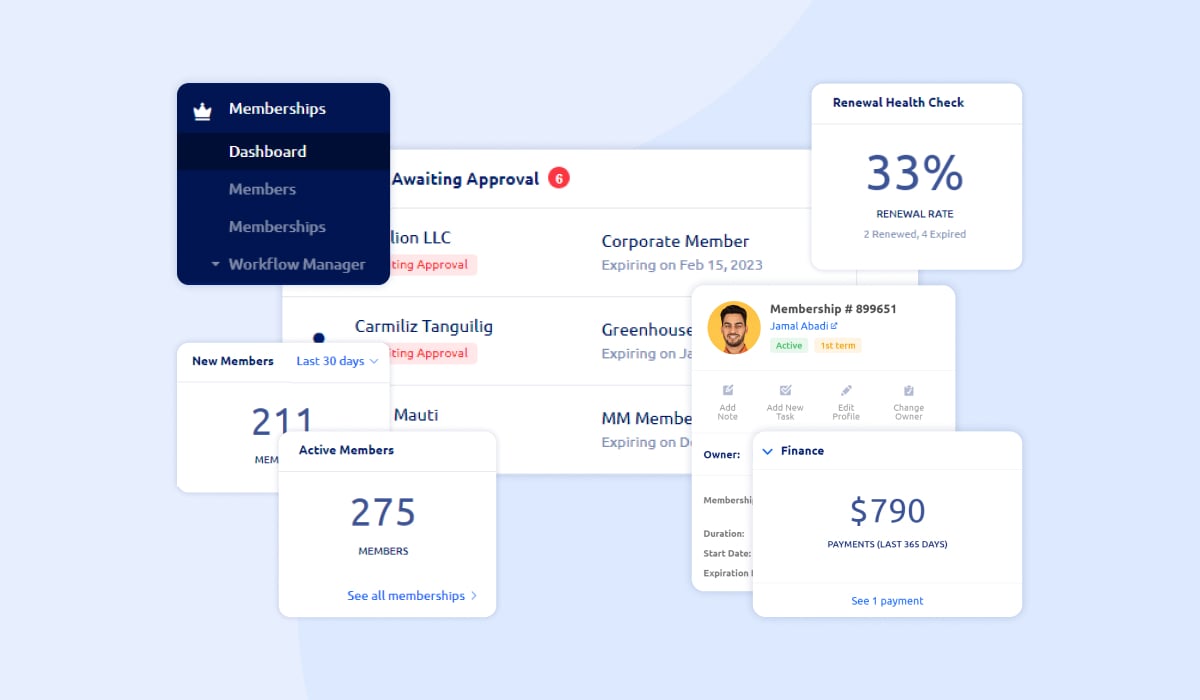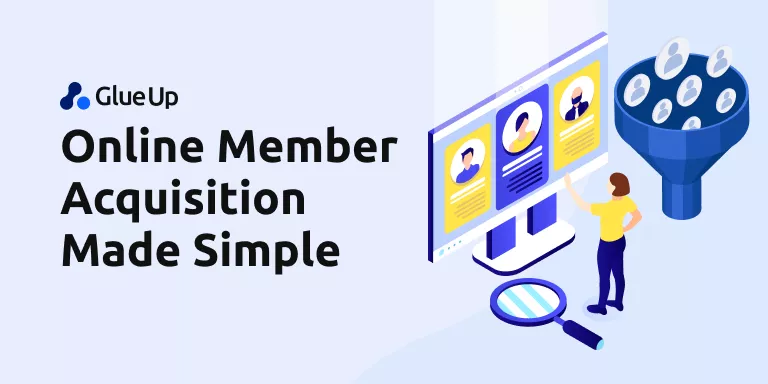
Attracting new members is crucial for any organization, especially in an increasingly competitive landscape. As markets become saturated and customer acquisition costs rise, leveraging data is essential for developing effective member-recruitment strategies.
Read on to explore how data can transform recruitment methods, enhance member engagement, and drive growth.
Key Takeaways
- Use analytics tools to track touchpoints, identify pain points in the conversion process, and understand member preferences.
- Analyze demographic, behavioral, and psychographic data to create detailed profiles of potential members.
- Employ advanced techniques like churn prediction, lifetime value forecasting, and conversion probability analysis.
- Define and quantify the total addressable market, compare current membership to potential market size, and calculate market penetration rates.
- Use engagement data to structure effective onboarding campaigns, prioritize content, and create early warning systems for disengaged new members.
1. Understanding Your Potential Members' Journey Through Data

One of the most significant advantages of using data in your member recruitment is the ability to map out and understand your potential members' journey. The information you collect about your members can guide you through the complex landscape of those behaviors.
Thus, data helps you understand the following key insights:
Touchpoint Mapping
By leveraging advanced analytics tools, you can track how potential members interact with your association online. This includes:
- Website visits (duration, pages viewed, interaction with specific elements)
- Social media interactions (likes, shares, comments)
- Email responses (open rates, click-through rates, conversion rates)
Identifying Pain Points
Examine your data patterns to uncover obstacles in the member journey that may be hindering conversions. Look for:
- High bounce rates on specific pages of your website
- Abandoned form submissions for event registrations or membership applications
- Drop-offs at particular stages of your membership application process
Preference Tracking
Use data to reveal preferences that influence a potential member's decision to join your association. This can include:
- Preferred communication channels (email, social media, direct mail)
- Content topics that generate the most interest
- Timing of interactions (e.g., days of the week or times of day when engagement is highest)
Action Steps for Your Association
- Implement tracking tools on your website and social media channels if you haven't already.
- Regularly analyze your data to identify patterns in how potential members interact with your association.
- Use these insights to optimize your website, content strategy, and communication timing.
2. Precision Targeting: Segmenting Your Potential Member Base

Data empowers you to adopt a more targeted and personalized approach to member recruitment. You can create detailed demographic, psychographic, and behavioral profiles of your audience by analyzing demographic, psychographic, and behavioral data.
Effective Segmentation Strategies for Your Association
Demographic Segmentation
Analyze your data to identify which demographic groups are most likely to become members. Consider different factors such as age ranges, geographic locations, industry sectors within your association's focus, and job titles or roles.
Behavioral Segmentation
Use data on past interactions and engagements to predict future behavior and tailor your recruitment efforts accordingly. Look at:
- Frequency of engagement with your content
- Types of events or webinars attended
- Resources downloaded or accessed on your website
Psychographic Segmentation
Understand the values, interests, and lifestyles of your potential members to create more resonant messaging. Consider:
- Professional goals and aspirations
- Challenges faced in their industry
- Preferred learning styles or professional development methods
Action Steps for Your Association
- Review your current member data to identify key segments within your association.
- Develop targeted messaging and offers for each segment.
- Test different approaches and continuously refine your segmentation strategy based on the results.
3. Leveraging Predictive Analytics for Your Association
The advent of advanced analytics techniques, such as predictive analytics and machine learning, can take your association's member recruitment to new heights. These technologies enable you to anticipate future member behavior based on historical data patterns.
Applications of Predictive Analytics in Your Member Recruitment

Churn Prediction
Identify potential members who are at risk of losing interest before they convert.
For example, develop a model that flags prospects who haven't engaged with your content in the last 30 days. You can also use predictive algorithms to estimate the likelihood of a prospect completing the membership application based on their interaction patterns.
Lifetime Value Prediction
Forecast the potential long-term value of a member to prioritize your recruitment efforts. This could involve:
- Analyzing historical data to identify characteristics of your high-value members.
- Predicting future engagement levels and potential upsell opportunities for different member profiles.
Conversion Probability
Predict which potential members are most likely to join, allowing for more targeted outreach. For instance:
- Create a scoring system for leads based on their similarity to successful conversions in the past.
- Use machine learning algorithms to identify the optimal timing for follow-up communications based on a prospect's engagement pattern.
Action Steps for Your Association
- Invest in predictive analytics tools or partner with data science experts to develop custom models for your association.
- Start with a pilot project focusing on one aspect of your recruitment process, such as churn prediction or lead scoring.
- Use the insights gained to refine your outreach strategies and resource allocation.
4. Market Saturation Analysis: Setting Realistic Growth Goals for Your Association
As an association leader, you might be tempted to set ambitious growth goals based solely on your current membership numbers.
However, a critical aspect of data-driven member recruitment is the analysis of market saturation. This approach helps you set more realistic and achievable recruitment targets.
Steps for Conducting a Market Saturation Analysis
Define Your Market
Clearly outline the characteristics of your ideal member.
For your association, this might include specific professions or industries, required certifications or qualifications, geographic scope (local, national, international), and career stage or experience level. Be as specific as possible to ensure you're targeting the right audience for your association.
When defining your market, it's also crucial to consider the pain points and challenges that your ideal members face.
- What are the common issues in their industry?
- What professional development needs do they have?
By understanding these factors, you can not only better define your market but also tailor your association's offerings to meet these needs. This deeper understanding will help you create a more compelling value proposition for potential members.
Quantify Your Total Addressable Market
Use data to estimate the total number of potential members that fit your criteria. Sources might include industry reports and statistics, government databases or census data, professional licensing boards, and professional networks like LinkedIn.
Don't limit yourself to just one source; cross-referencing multiple data points can give you a more accurate picture of your total addressable market.
When quantifying your market, it's important to also consider future trends and potential market shifts.
- Are there emerging professions or industries that might fall within your association's scope in the coming years?
- Are there demographic changes that could impact your potential member base?
By looking not just at current numbers but also at projected growth or decline in various sectors, you can get a more comprehensive view of your total addressable market over time.
This forward-thinking approach can help you make strategic decisions about where to focus your recruitment efforts and how to position your association for long-term growth.
Compare Your Current Membership
Analyze how your current membership numbers stack up against the total addressable market. Calculate your market penetration rate: Market Penetration Rate = (Current Members / Total Addressable Market) x 100
Identify Growth Opportunities
Based on your market penetration rate, determine your growth strategy:
- If market saturation is low (e.g., <20%), focus on aggressive recruitment strategies.
- If market saturation is high (e.g., >70%), consider retention efforts, expanding your market definition, or diversifying your offerings.
5. Data-Informed Onboarding: Ensuring Long-Term Member Success in Your Association
While recruitment is crucial, your member journey doesn't end at conversion. Data plays a vital role in creating effective onboarding processes that set your new members up for long-term success and engagement with your association.
Key Elements of Data-Driven Onboarding for Your Association

Email Engagement Analysis
Use data on open rates, click rates, and optimal send times to structure your onboarding email campaign. For example:
- Analyze which subject lines generate the highest open rates (e.g., "Welcome to [Association Name]!" vs. "Your Membership Journey Begins")
- Determine the ideal number of onboarding emails based on engagement metrics (too few may not provide enough information, while too many may overwhelm new members)
- Identify the best times to send emails based on when your members are most likely to engage
Content Prioritization
Analyze which topics and resources new members engage with most to prioritize the most valuable information during onboarding. This might involve:
- Tracking which sections of your member portal are accessed most frequently by new members
- Monitoring downloads or views of specific resources to understand what new members find most valuable
- Analyzing survey responses to identify the benefits or features that new members are most excited about
Early Warning Systems
Use data to identify new members who are not engaging with onboarding materials and trigger personalized outreach. This could include setting up alerts for members who haven't logged into the member portal within the first week.
Identify members who haven't opened any onboarding emails and reach out through alternative channels. Track completion rates of onboarding steps and intervene if a member seems stuck at a particular stage.
Implementing an early warning system goes beyond just identifying disengaged members; it's about creating a proactive culture of member success within your association. Consider developing a tiered response system where different levels of intervention are triggered based on the severity or duration of disengagement.
For example, a mild intervention might involve sending a personalized email with helpful resources, while a more serious case might warrant a phone call from a membership advisor. By catching potential issues early and addressing them promptly, you can significantly reduce member churn and foster a sense of care and attention that strengthens the bond between your association and its members.
Remember, the goal is not just to retain members, but to transform potentially disengaged individuals into active, satisfied participants in your association's community.
Action Steps for Your Association
- Review your current onboarding process and identify areas where data can inform improvements.
- Implement tracking systems to monitor new member engagement during the onboarding period.
- Develop personalized onboarding paths based on member segments and individual behaviors.
- Create an early warning system to identify and re-engage at-risk new members.
7. Building Long-Term Relationships Through Continuous Data Analysis in Your Association
The benefits of data-driven strategies extend far beyond initial recruitment. By continuously collecting and analyzing data, your association can nurture long-term relationships with members, fostering loyalty and advocacy.
Strategies for Long-Term Relationship Building in Your Association:
- Monitor member interactions and engagement levels over time to identify opportunities for re-engagement or additional value delivery.
- Use data from surveys, social media interactions, and direct feedback to continuously refine your offerings and member experience.
- Develop models that predict member churn risk, allowing for proactive retention efforts. Define and track key performance indicators (KPIs) that indicate member success and satisfaction.
8. Leveraging Association Management Software (AMS) for Data-Driven Recruitment

As you implement data-driven strategies for member recruitment, one tool that can significantly enhance your efforts is Association Management Software (AMS).
An effective AMS serves as a centralized hub for all your association's data, from member information and event registrations to financial transactions and engagement metrics.
By consolidating your data into a single platform, an AMS allows you to generate comprehensive reports and analytics that can inform your recruitment strategies.
You can easily track member acquisition rates, identify trends in member engagement, and measure the success of various recruitment campaigns. This holistic view of your association's data can help you make more informed decisions about where to allocate your resources for maximum impact.
One example of an AMS that offers these capabilities is Glue Up.
Glue Up’s AI-powered AMS provides associations with tools for member management, event organization, email marketing, and data analytics. Its intuitive interface allows you to easily access and interpret your association's data, helping you make data-driven decisions about your recruitment and engagement strategies.
Glue Up's features include customizable dashboards that give you a real-time overview of your association's performance, advanced segmentation tools for targeted communications, and built-in analytics that help you measure the success of your initiatives. While there are many AMS options available in the market, Glue Up stands out for its user-friendly design and comprehensive feature set.
When choosing an AMS for your association, consider factors such as ease of use, scalability, integration capabilities with your existing tools, and the depth of analytics provided.
Whether you opt for Glue Up or another solution, implementing a robust AMS can be a game-changer in your association's ability to leverage data for successful member recruitment and engagement.
For more information regarding association management software, click here to get a demo and discover how Glue Up can you can take your data-driven recruitment strategies to the next level.



